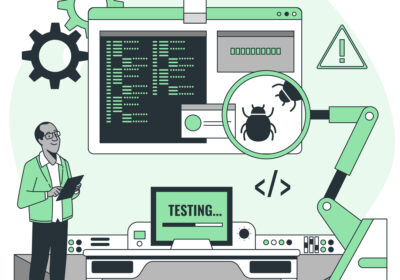In today’s fiercely competitive software development landscape, delivering high-quality applications on time and within budget is no easy feat. The key to success lies in establishing a well-defined and optimized development process that prioritizes efficiency, collaboration, and robust software creation. This blog delves into 10 effective strategies that can streamline your software development process, fostering a productive and quality-driven development environment.
-
Embrace Agile Methodologies for Flexible and Iterative Development:
Traditional, waterfall-style development methodologies often struggle to adapt to the ever-changing demands of the software market. These methodologies typically involve a linear, sequential approach where requirements are rigidly defined upfront, followed by lengthy development, testing, and deployment phases. However, this rigidity can lead to challenges in accommodating evolving user needs or market trends that emerge during the development process.
For instance, imagine developing a social media application using a waterfall methodology. You meticulously define all features and functionalities upfront, only to discover six months into development that user preferences have shifted, and a completely different feature set is now desired. This scenario can be financially disastrous and significantly delay the launch of your application.
-
Foster a Culture of Clear Communication and Collaboration: Breaking Down Silos
Effective communication is the lifeblood of a successful software development process. Unfortunately, development teams, designers, product managers, and stakeholders often operate in silos, leading to misunderstandings, delays, and missed opportunities. To bridge these communication gaps, it’s crucial to establish a culture of transparency and collaboration.
Imagine a scenario where a developer is diligently coding a new feature based on a product requirement document (PRD) created months ago. However, due to a lack of communication, the product manager has since decided to pivot the application’s focus, rendering the developer’s work irrelevant. By fostering a culture of open communication, the product manager could have shared the strategic shift with the development team during a stand-up scrum, allowing the developer to redirect their efforts towards the newly prioritized feature.
-
Implement Version Control Systems: Maintaining Codebase Integrity
Version control systems (VCS) like Git are essential tools for managing code changes, tracking revisions, and facilitating efficient collaboration within development teams. Imagine a team of developers working on a complex codebase without a VCS. They might accidentally overwrite each other’s work, introduce bugs, and struggle to identify the source of issues. VCS eliminates this chaos by allowing developers to work on different parts of the codebase simultaneously. Each developer creates a local copy of the code (branch) and pushes their changes to a central repository (main branch) when complete. VCS meticulously tracks all revisions, allowing developers to revert to previous versions if necessary and maintain a clear history of code changes.
-
Prioritize Continuous Integration and Continuous Delivery (CI/CD): Automating Efficiency
Continuous integration (CI) and continuous delivery (CD) are two powerful practices that automate key stages of the software development process, drastically improving efficiency and reducing the likelihood of errors. CI involves automating the process of integrating code changes from various developers into a central repository frequently (often multiple times a day). This frequent integration allows for early detection and resolution of merge conflicts, preventing issues from snowballing into larger problems later in the development cycle.
Following the integration stage comes continuous delivery (CD). CD automates the building, testing, and deployment of the software. Imagine a scenario where a developer manually builds and deploys the software after every code change.
-
Invest in Automation Testing: Building Quality In
Manual testing, while crucial for catching specific user interface bugs and usability issues, can be a time-consuming and laborious process. Incorporating a robust suite of automated testing tools throughout the development lifecycle significantly improves efficiency and code quality. By automating these different types of tests, development teams can achieve broader test coverage with less manual effort. Automated tests can be run frequently throughout the development cycle, providing developers with immediate feedback on code quality and potential issues. This not only reduces the risk of bugs reaching production but also allows developers to focus their manual testing efforts on more complex scenarios that are difficult to automate.
-
Leverage Code Reviews and Pair Programming: Building Knowledge and Quality
Code reviews and pair programming are two valuable techniques that promote knowledge sharing, improve code quality, and foster a collaborative development environment. Code reviews involve experienced developers reviewing the code written by their peers. This collaborative approach allows for the identification of potential errors, adherence to coding standards, and opportunities for code optimization. During code reviews, senior developers can share best practices, identify areas for improvement, and guide junior developers in writing cleaner and more efficient code.
Pair programming takes collaboration a step further. In this technique, two developers work together on a single unit of code, typically on the same workstation. One developer acts as the driver, writing the code, while the other developer acts as the navigator, reviewing the code in real-time, suggesting improvements, and identifying potential issues.
-
Utilize Project Management Tools: Keeping Everyone Aligned
Software development projects can be complex undertakings involving multiple teams, diverse tasks, and ever-evolving priorities. Project management tools are invaluable assets for streamlining these complex projects and ensuring everyone is aligned with project goals. These tools offer features like task boards, Kanban boards, sprint tracking, and bug tracking functionalities.
Task boards provide a visual representation of the development workflow, allowing teams to track the progress of individual tasks, identify dependencies, and visualize bottlenecks. Kanban boards, with their focus on limiting work in progress (WIP), promote agility and help teams focus on completing high-priority tasks first. Sprint tracking functionalities within Agile methodologies allow teams to monitor progress within each sprint cycle and identify areas requiring additional resources or adjustments. Bug tracking functionalities provide a centralized platform for logging, prioritizing, and resolving software bugs, ensuring a smooth development process and a high-quality final product.
-
Prioritize Documentation: Knowledge Transfer and Long-Term Maintainability
Clear and concise documentation is often an underrated aspect of the software development process. However, well-structured documentation plays a crucial role in knowledge transfer, onboarding new team members, and maintaining long-term code maintainability. Imagine a scenario where a developer leaves the team midway through a project, and the remaining team members have no documentation to understand the codebase or the rationale behind certain design decisions. This can lead to significant delays, errors, and frustrations as the team attempts to decipher the code without proper context.
Investing in creating comprehensive documentation ensures a smooth knowledge transfer process and reduces reliance on individual developers.
-
Gather User Feedback Continuously: Building Software Users Love
The ultimate goal of software development is to create applications that users find valuable and enjoyable to use. Unfortunately, development teams can sometimes get caught up in internal technical discussions and lose sight of the user’s perspective. To ensure your software resonates with your target audience, it’s crucial to gather user feedback continuously throughout the development process.
There are various methods for gathering user feedback, each with its own strengths:
- User Interviews: Conducting in-depth interviews with potential users allows you to understand their needs, pain points, and expectations. Through open-ended questioning and active listening, you can gain valuable insights that can inform the design and development of the software.
- Surveys: Online surveys can be a cost-effective way to gather feedback from a larger pool of users. Surveys allow you to gather quantitative data on user preferences, identify areas for improvement, and measure user satisfaction with existing features.
- A/B Testing: This technique involves presenting two different versions of a user interface element (e.g., button design, layout) to a small subset of users and analyzing which version performs better in terms of user engagement or conversion rates. A/B testing allows for data-driven decision making and ensures the user interface is optimized for user experience.
By actively soliciting and analyzing user feedback throughout the development process, you can ensure your software is user-centric and addresses the needs of your target audience. Remember, users are the ultimate judges of your software’s success. Prioritizing user feedback allows you to build applications that users love and that will thrive in the competitive software market.
-
Embrace a Culture of Learning and Continuous Improvement: The Evolving Landscape
The software development landscape is constantly evolving. New technologies, frameworks, and development methodologies emerge at a rapid pace. To stay ahead of the curve and deliver high-quality software, it’s crucial to foster a culture of continuous learning within your development team.
Encourage your team members to attend workshops, conferences, and online courses to stay up-to-date on the latest advancements in their field. Subscription services like Pluralsight or LinkedIn Learning offer a vast library of video tutorials and courses on various programming languages, frameworks, and software development best practices. Additionally, consider organizing internal knowledge-sharing sessions where team members can present on new technologies they’ve learned or best practices they’ve discovered.
Conclusion: Building Software the Right Way
In conclusion, streamlining your software development process is not about implementing a rigid set of rules but rather establishing a continuous cycle of optimization. By embracing the 10 strategies outlined in this blog, you can foster a collaborative and efficient development environment that prioritizes clear communication, knowledge sharing, and user-centric design. Invest in automation tools, prioritize quality through code reviews and testing, and continuously gather user feedback to ensure your software remains relevant and valuable.





